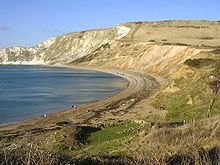User:Huligan0/Flower's Barrow

Flower’s Barrow is an Iron Age hillfort, built over 2500 years ago, above Worbarrow Bay in Dorset on the south coast of England.
Location[edit]
Flower’s Barrow is located about 16 kilometres from Swanage and about six kilometres south of Wareham.
Towering to the north over Worbarrow Bay is Flower’s Barrow ridge. This forms the western end of the ridge which runs all the way to Ballard Point north of Swanage. The ancient hillfort of Flower's Barrow rises behind the beach at Arish Mell in the Lulworth military range. The hill lies directly west of the ghost village of Tyneham. Flower’s Barrow has a limited future because the southern part is falling into the sea at Worbarrow Bay due to coastal erosion. Probably half of it has already disappeared.
Access to Flower’s Barrow hillfort is solely possible by foot, either from Tyneham, with an steep uphill walk, or alternatively from the viewing point and car park at Whiteway Hill walking along the hill to the west.
Hillfort[edit]
This early Iron Age hillfort, that was taken over by the Romans when they invaded, has double and triple ramparts. The pair of parallel double ramparts are unmistakably visible to the west and east sides. It is possible there never were ramparts on the southern end, because the cliff face acted as defence.
The coastal erosion has exposed several sections of the interior of the hillfort. There are hut circles visible within the interior. Fragments of Iron Age pottery, sling-stones, and bones were found in a minor excavation in 1939 in a pit near the western entrance. Further landslides have revealed the floor of the hillfort. With the continual ground disturbances at the southern edge, it is possible that further archaeological finds can easily be discovered. However, the twin hazards of cliff erosion and the possibility of unexploded tank shells dictate extreme caution.
Jurassic Coast[edit]
Flower’s Barrow, Arish Mell and Worbarrow Bay are part of the Jurassic Coast, a World Heritage Site. The coastal exposures along the Jurassic coastline provide a continuous sequence of Triassic, Jurassic and Cretaceous rock formations spanning approximately 185 million years of the Earths history. The rocks along the Jurassic Coast dip gently to the east. Due to this tilting and due to erosion the oldest exposed rocks are found in the west. The younger Cretaceous rocks form the cliffs here in the east[1].
- For further Jurassic sites see: List of places on the Jurassic Coast
Geology[edit]

The steep angular layers of rock, that are clearly visible in the bay, reveal the complex sedimentary folding that disturbed the geology in this vicinity. These folds were caused by tectonic pressures some 30 million years ago as the African and European continents collided. At this time the cliff sediments were twisted horizontally and this is why the Chalks that are between 85 to 145 million years old are found at the rear of the bay. The sediments that form Mupe Ledges, the Mupe Rocks and the peninsula Worbarrow Tout are 150 million year old Portland Limestone and 147 million year old Purbeck Beds[2] .
References[edit]
- ^ "Dorset and East Devon Coast". UNESCO World Heritage Centre. 2001. Retrieved 2010-11-16.
{{cite web}}: Cite has empty unknown parameter:|coauthors=(help) - ^ "West, I.M. (2008) Worbarrow Bay, Dorset; Geology of the Wessex Coast of England". Retrieved 2010-11-16.
Bibliography[edit]
- The Jurassic Coast Trust (2003). A Walk Through Time, the Official Guide to the Jurassic Coast. Coastal Publishing. ISBN 978-0-9544845-0-7.
{{cite book}}: Cite has empty unknown parameter:|unused_data=(help)
